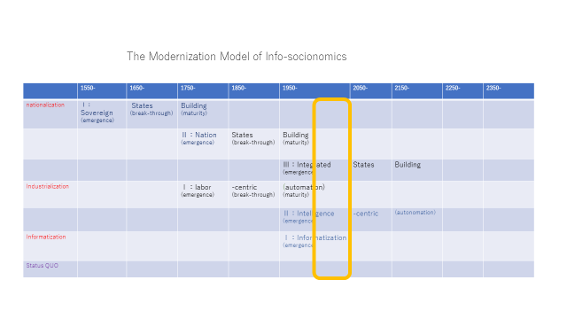The core philosophy of Infosocionomics is crystalized in the Infosocionomics Modernization Model, created by Prof. Dr. Shumpei Kumon. This model aims at unlocking the basic architecture of modernization, depending on two fundamental concepts. The first concept is the super-imposition of three dynamisms, namely, nationalization (the political dynamism), industrialization (the economic dynamism) and informatization (the social dynamism). The second concept is the time sequential phase-transfiguration pattern of the status of the modern social system. The process of phase-transfiguration places the three phases in a sigmoid curve, namely, the emergence phase, the breakthrough phase and the maturity phase.
Statization had launched in the middle of the 16th century. During the period between the middle of 16th century and the middle of 18th century, the dominant feature of statization was sovereign states building (Statization Ⅰ). The period between the middle of 18th century and the middle of 20th century, the dominant feature of statization was nation-states building (Statization Ⅱ). Since the middle of 20th century, integrated-states building has been progressing more significantly.
We can summarize the Status Quo of statization as the super-imposed status of the maturity phase of Statization Ⅱ(nation-states building) and the emergence phase of Statization Ⅲ(integrated-states building). At this moment, the majority of existing states are nation-states, holding the dominant authority in the world system. We need to notice, at the same time, however, the importance of a new polity of integrated-states, enhancing progressively day by day.
Industrialization had launched in the middle of 18th century. The period between the middle of 18th century and the middle of 20th century, the dominant feature of industrialization has been labor-centric industrialization (automation, IndustrializationⅠ). Since the middle of 20th century, intelligence-centric industrialization (autonomation, IndustrialiationⅡ) has been taking the position of the significant feature progressively.
We can summarize the Status Quo of industrialization as the super-imposed status of the maturity phase of IndustrializationⅠ(labor-centric industrialization) and the emergence phase of IndustrializationⅡ(intelligence-centric industrialization). At this moment, the majority number of industrial firms engage in labor-centric industrialization, and labor-centric industrialization hold the dominant authority in the world economic system. We need to notice, at the same time, the importance of the new modality of intelligence-centric industrialization which has been enhancing progressively day by day.
Informatization has launched in the middle of 20th century, and overall digitization of the society has been on progress.
According to our model, one can expect the emergence of a new phase of informatization (InformatizationⅡ) in the middle of 22nd century, though it is not sure.
Following the above results, we can draw out the Doctrine of the Infosocionomics Modernization Model, that states that the basic architecture of the Status Quo of the modern social system is a kind of equilibrium in the super-imposition of the three factors. Namely, the combination of (a) the maturity phase of nation-states building, (b) the emergence phase of integrated-states building, and (c) the super-imposition of the maturity phase of labor-centric industrialization and the emergence phase of intelligence-centric industrialization.
The Doctrine of the Infosocionomics Modernization Model will be described in a formula:
The Doctrine of the Infosocionomics Modernization Model
The Architecture of the Present Modern Society
= (Nation-States Building + Integrated-States Building)
+ (Labor-Centric Industrialization + Intelligence-Centric Industrialization)
+ Informatization
In another terminology,
The Architecture of the Present Modern Society
= (The Maturity Phase of NationalizationⅡ + The Breakthrough Phase of NationalizationⅢ)
+ (The Maturity Phase of IndustrializationⅠ+ The Emergence Phase of Industrialization Ⅱ)
+ The Emergence Phase of Informatization

